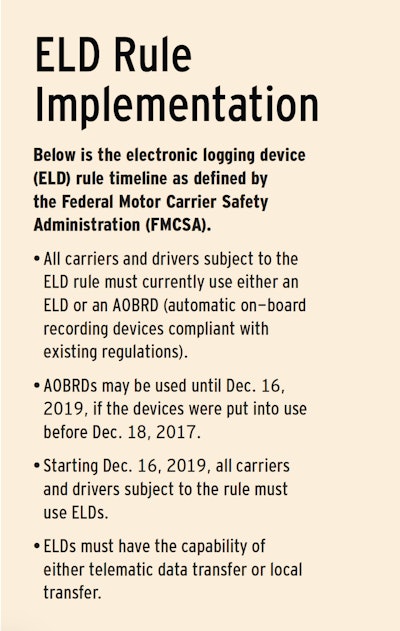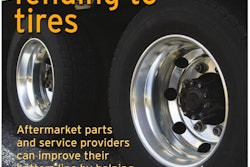The following comes from the November 2018 issue of Truck Parts & Service. To read a digital version of the magazine, please click the image below.

Few regulations imposed on the trucking industry have been as newsworthy as the Federal Motor Carrier Safety Administration’s (FMCSA) electronic logging device (ELD) rule.
Formally proposed in 2015 and implemented last December, the ELD rule has been a lightning rod for controversy in the fleet and driver communities. Many carriers have supported the rule as a safety and efficiency measure, while the driver community has fought against what it viewed as an intrusive and unnecessary government regulation.
The aftermarket has been fortunate to be able to witness this debate from afar, essentially unimpacted by the requirements of the rule on its businesses.
But just because the ELD rule doesn’t directly impact aftermarket businesses doesn’t mean the industry should ignore it. By forcing truck owners to integrate ELDs into their vehicles, FMCSA’s rule has fundamentally altered how aftermarket customers do business.
Aftermarket operations willing to invest time understanding those changes and offering products that cater to customers’ new normal will better position themselves as trusted solutions providers and partners in the marketplace.
The nuts and bolts of the ELD rule
FMCSA’s ELD rule (also known as the ELD mandate) was implemented Dec. 18, 2017, after many years of development and debate as a way for truckers to re-cord their hours of service (HOS).
First proposed nearly a decade prior, FMCSA promoted the mandate as a safety and efficiency measure. In the 2015 Final Rule published regarding the impending regulation, FMCSA wrote the rule was enacted to “improve commercial motor vehicle safety and reduce the overall paperwork burden for both motor carriers and drivers by increasing the use of ELDs within the motor carrier industry, which will, in turn, improve compliance with the applicable hours-of-service rules.”
The ELD rule is a comprehensive regulation and impacts nearly all trucks and drivers on American roadways. FMCSA writes in its ELD Rule — Facts for the Commercial Motor Vehicle Industry pamphlet that the mandate “applies to most motor carriers and drivers who are required to keep records of duty status (RODS). This includes commercial buses as well as trucks. It applies to drivers domiciled in Canada and Mexico, unless they qualify for an exception to the rule.”

“The rule is intended to help create a safer work environment for drivers and make it easier and faster to accurately track, manage and share RODS data,” FMCSA writes in its ELD Rule pamphlet.
Many truckers, particularly owner-operators and small fleets, have not viewed the mandate as favorably.
The Owner-Operator Independent Driver Association (OOIDA), the largest entity supporting commercial truck drivers in North America, has vocally opposed the ELD rule since its inception, citing the financial burden to the truck-ing community as well as “significant technological and real-world concerns” that were not addressed by FMCSA in writing the Final Rule.
The association requested a delay of the mandate’s implementation last November and in March submitted a letter to Congress requesting the Committee on Transportation & Infrastructure to “urgently conduct an oversight hearing on the critically flawed implementation” of the mandate.
OOIDA wrote at the time the number of temporary exemptions FMCSA granted regarding the rule — which included a 90-day waiver for lease and rental fleets and an exemption for livestock haulers — created confusion and uncertainty in the driver community and that “the impact of the rule has been much broader than even its most ardent supporters anticipated.”
For the most part these efforts have been fruitless.Congress has yet to suspend or scrap the mandate and in July denied a petition by OOIDA requesting the U.S. Department of Transportation (USDOT) grant a reprieve from ELD compliance for small carriers with clean safety records. In June, U.S. Rep. Kevin Cramer (R-N.D.) introduced a bill on the House floor that would require USDOT to conduct a study to determine how many drivers quit the trucking industry over the mandate, but the bill received no support and stalled on the House floor.
What the ELD rule means to the aftermarket
For aftermarket businesses the ELD mandate’s impact stretches far beyond the simple sale of logging devices. The rule’s requirements and exemptions are forcing vehicle owners and drivers to make tough decisions regarding their operations and their future.
Each decision offers opportunities for the aftermarket channel.
Truck owners who oppose the mandate and are choosing to run pre-2000 MY trucks to avoid it represent a small portion of the overall U.S. fleet but are overwhelmingly reliant on the independent aftermarket to keep their assets on the road. In making the conscious decision to turn away from new vehicles and vehicle technology to remain free from government regulation, these truck owners have committed their businesses to older equipment that require frequent proactive maintenance and service.
Aftermarket parts and service operations can identify these truck owners within their customer base and area of operation and carefully stock and sup-port legacy product lines for 1999 and earlier MY trucks to cater to their needs.
Another aftermarket advantage created by the ELD rule is technology acceptance. Many truck owners and drivers complying with the mandate have dis-covered ELD devices aren’t as intrusive as first assumed.
“We’ve been hearing more of a positive reaction to [the rule],” says Tom Reader, senior director of marketing, ELD, at J.J. Keller, which has offered an electronic HOS recording solution in its product suite since 2009.
Reader says J.J. Keller’s product offer-ing includes a base service for HOS re-cording to comply with the mandate but says a large segment of the company’s users actually use J.J. Keller’s products as more than just driver logs.
KeepTruckin’ customers are doing the same, adds Seth Spiel, head of products, telematics.
“Originally, customers were very cautious and we understand that. Any change can be scary and intimidating,” he says. But during the past year “we are beginning to see an appreciation for the technology.”
Both KeepTruckin’ and J.J. Keller solutions include asset management options to monitor vehicle and driver performance, such as fuel economy, GPS tracking, driver metrics and more. The companies say truck owners and drivers become more receptive to those options once they have familiarized themselves with electronic HOS recording.
Spiel says KeepTruckin’ wants to be the “TurboTax of trucking,” a simple, user-friendly tool drivers can rely on “to get on with their jobs and their lives.”
That focus on carrier efficiency is proving to be the most valuable route toward ELD and related product sales for HDA Truck Pride members, says Tina Hubbard, vice president of marketing and product management. Hubbard says most HDA Truck Pride members stock and sell ELD products but those who are having the most success moving those units are the distributors who sell them as a solution rather than a single product.
For HDA Truck Pride, the solution of choice has been vehicle telematics.
“Selling a logging device is kind of a one-time deal, but if you sell a device with diagnostic capabilities, now you’re selling more of a solution,” she says.
Over the past five years HDA Truck Pride has entered into distribution partnerships with multiple businesses selling all-makes telematics devices with ELD rule capabilities, including GoFleet and Navistar’s OnCommand. In each case she says HDA Truck Pride’s decision of partner was rooted more in the long-term service and maintenance partnership potential for its distributors and their customers than any one-time ELD sale.
“In our industry a vehicle owner has the authority to share their diagnostic information with anyone they wish and we want our members to have access to those fault codes,” Hubbard says. “If we can get that person who owns the truck to share what is happening with that vehicle to our member or [Truck Service Expert], they can serve that customer immediately.”
And ELD and telematics providers are promoting this potential to their users as well.
Geotab, which produces the vehicle tracking devices used by GoFleet and other ELD solutions, says its tools are designed to record as much vehicle data as possible, explains Scott Sutarik, associate vice president, commercial vehicle solutions.
For truck owners new to telematics, Sutarik says Geotab recommends customers choose a handful of data sets they deem highest priority to address first — such as route optimization or driver braking habits — then expand to monitor other categories over time.
“If you start with 30 tasks, you’re not going to get a lot done,” he says.
Hubbard agrees, noting data sharing is another area where the aftermarket can be of assistance. Sharing vehicle diagnostic data is a way for truck owners to out-source some of their fleet maintenance responsibilities to their trusted parts and service partners.
“It’s a huge benefit to everyone in the industry,” she says.
And the best part, experts say, are most truck owners and drivers are receptive to the conversation.
“I think an ELD [solution] is an expectation from new drivers today and veteran drivers now understand why fleets want to have that technology to understand their assets,” Reader says.











